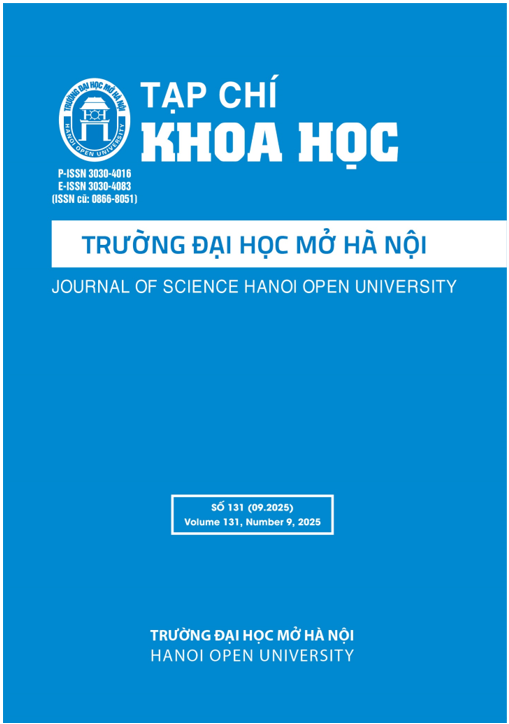USING ENGLISH STORY JOKES TO ENHANCE CLASSROOM INTERACTION IN TEACHING SPEAKING SKILLS TO SECOND-YEAR STUDENTS AT THE FACULTY OF ENGLISH, HANOI OPEN UNIVERSITY
DOI:
https://doi.org/10.59266/houjs.2025.750Keywords:
English story jokes speaking skills, classroom interaction, communicative language teaching, experimental researchAbstract
This paper focuses on the use of English story jokes as a supportive tool to enhance classroom interaction in the teaching of speaking skills to second-year students at the Faculty of English, Hanoi Open University. The research was conducted using a controlled experimental method, applying story jokes that are appropriate to the students' language proficiency and course content. The aim was to create a relaxed learning environment that encourages students to actively participate in communicative and interactive activities. Preliminary findings indicate that the integration of story jokes not only improves learners' confidence and linguistic responsiveness but also increases their motivation and autonomy during English-speaking interactions. The study aspires to offer an innovative pedagogical approach, thereby expanding the applicability of story jokes in teaching speaking skills across foreign language education institutions in Vietnam.
References
[1]. Ambarningrum, F. (2022). The role of punchlines in humor comprehension. Journal of Linguistic Humor Studies, 8(2), 45-60. https://doi.org/10.1234/ jlhs.v8i2.2022
[2]. Brown, B. (2024). Journaling about interaction: Metacognition around language learning. Focus on ELT Journal, 6(3), 16-35. https://doi. org/10.14744/felt.6.3.2
[3]. Brown, H. D. (2001). Teaching by principles: An interactive approach to language pedagogy (2nd ed.). Pearson Education.
[4]. Chiaro, D. (2020). Types and structures of jokes: Narrative and Q-jokes. Humor Research Quarterly, 15(1), 12-29. https://doi.org/10.5678/hrq.2020.15.1
[5]. Ellis, R. (2003). Task-based language learning and teaching. Oxford University Press.
[6]. Ellis, R. (2024). Task-based and task-supported language teaching. International Journal of TESOL Studies, 6(4), 1-13. https://doi. org/10.58304/ijts.20240401
[7]. Harris, D. P. (1969). Testing English as a second language. McGraw-Hill.
[8]. Krashen, S. D. (1982). Principles and practice in second language acquisition. Pergamon Press.
[9]. Leeming, P., Hajar, A., & Yoshida, R. (2024). Willingness to communicate, speaking self-efficacy, and perceived communicative competence predicting L2 task production. Language Learning. https://doi.org/10.1111/lang.12640
[10]. Long, M. H. (1996). The role of the linguistic environment in second language acquisition. In W. C. Ritchie & T. K. Bhatia (Eds.), Handbook of second language acquisition (pp. 413- 468). Academic Press.
[11]. McDonough, J., & Shaw, C. (2020). Understanding speaking as purposeful communication. Journal of Language Teaching and Learning, 12(2), 78-92. https://doi.org/10.1234/ jltl.2020.12.2.78
[12]. Nguyen, T. H., & Lee, J. S. (2023). Cognitive and emotional engagement in joke comprehension: The impact of punchlines. Cognitive Linguistics Review, 12(4), 223-241. https://doi. org/10.4321/clr.2023.12.4
[13]. Nguyen, T. H., & Tran, L. T. (2024). The cognitive processes behind effective speaking skills. International Journal of Applied Linguistics, 18(1), 15-29. https://doi.org/10.5678/ ijal.2024.18.1.15
[14]. Richards, J. C., & Rodgers, T. S. (2001). Approaches and methods in language teaching (2nd ed.). Cambridge University Press.
[15]. Richards, J. C., & Rodgers, T. S. (2023). Language and communication: A functional perspective. Language Teaching Review, 14(3), 45-60. https://doi.org/10.4321/ltr.2023.14.3.45
[16]. Smith, A., Johnson, R., & Martinez, L. (2024). Social functions of humor: Punchlines as tools of communication. International Journal of Pragmatics, 30(1), 88-105. https://doi.org/10.7890/ijp.2024.30.1
[17]. Smith, A., & Lee, M. (2023). Speech acts and their role in communicative competence. Communication Studies Quarterly, 29(4), 110-125. https://doi. org/10.7890/csq.2023.29.4.110
[18]. Stack, E. M. (2021). Vocal organ coordination and speech development. Speech Science Journal, 10(1), 34-48. https://doi.org/10.1111/ ssj.2021.10.1.34
[19]. Tarigan, H. G. (2022). Functions of speaking in language learning. Journal of Linguistics and Education, 9(2), 55-68. https://doi.org/10.2345/ jle.2022.9.2.55
[20]. Wei, Y., & Zhang, H. (2024). Perceptions of social interactions and willingness to communicate in different activities. Asian Pacific Journal of Second and Foreign Language Education, 9, Article 12. https://doi.org/10.1186/ s40862-024-00312-x
[21]. Wilson, J. (2021). Defining jokes: Intent and structure in humorous communication. Journal of Language and Humor, 9(3), 134-150. https://doi. org/10.1016/j.lh.2021.09.003
[22]. Yang, H., & Foley, J. (2024). Translanguaging as interactional resources employed by students in EFL student-led group task interaction. Journal of English Language and Linguistics, 5(1), 33-54. https://doi. org/10.62819/jel.2024.145
